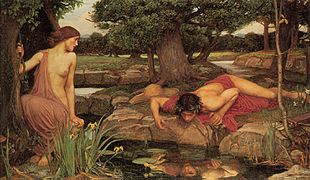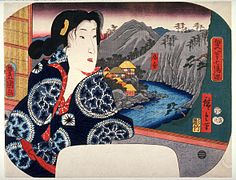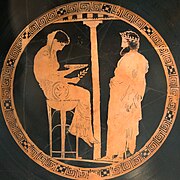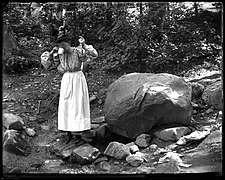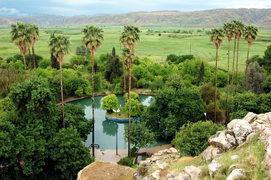Spring (hydrology)


Aspringis a natural exit point at whichgroundwateremerges from theaquiferand flows onto the top of theEarth's crust(pedosphere) to becomesurface water.It is a component of thehydrosphere,as well as a part of thewater cycle.Springs have long been important forhumansas a source offresh water,especially inaridregions which have relatively little annualrainfall.
Springs are driven out onto the surface by various natural forces, such asgravityandhydrostatic pressure.A spring produced by the emergence ofgeothermally heatedgroundwater is known as ahot spring.Theyieldof spring water varies widely from avolumetric flow rateof nearly zero to more than 14,000 litres per second (490 cu ft/s) for the biggest springs.[1]
Formation
[edit]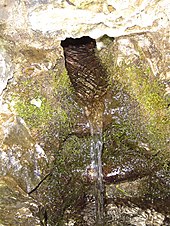
Springs are formed whengroundwaterflows onto the surface. This typically happens when thewater tablereaches above the surface level, or if the terraindepressessharply. Springs may also be formed as a result ofkarst topography,aquifersorvolcanic activity.Springs have also been observed on theocean floor,spewing warmer, low-salinitywater directly into the ocean.[2]
Springs formed as a result ofkarsttopographycreatekarst springs,in which ground water travels through a network of cracks and fissures—openings ranging from intergranular spaces to largecaves,later emerging in a spring.
The forcing of the spring to the surface can be the result of a confinedaquiferin which the recharge area of the spring water table rests at a higher elevation than that of the outlet. Spring water forced to the surface by elevated sources areartesian wells.This is possible even if the outlet is in the form of a 300-foot-deep (91 m) cave. In this case the cave is used like a hose by the higher elevated recharge area of groundwater to exit through the lower elevation opening.
Non-artesian springs may simply flow from a higher elevation through the earth to a lower elevation and exit in the form of a spring, using the ground like a drainage pipe. Still other springs are the result of pressure from an underground source in the earth, in the form ofvolcanicormagmaactivity. The result can be water at elevated temperature and pressure, i.e.hot springsandgeysers.
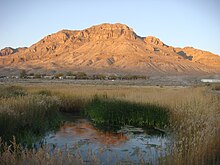
The action of the groundwater continually dissolves permeable bedrock such aslimestoneanddolomite,creating vast cave systems.[3]
Types
[edit]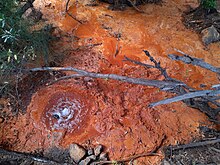
- Depression springs occur along a depression, such as the bottom ofalluvial valleys,basins, orvalleysmade of highly permeable materials.[4]
- Contact springs, which occur along the side of a hill or mountain, are created when thegroundwateris underlaid by an impermeable layer of rock or soil known as an aquiclude or aquifuge[4]
- Fracture, or joint occur when groundwater running along an impermeable layer of rock meets a crack (fracture) or joint in the rock.[4]
- Tubular springs occur when groundwater flows from circular fissures such as those found in caverns (solution tubular springs) or lava tubular springs found inlava tubecaves.[5][6]
- Artesian springstypically occur at the lowest point in a given area. An artesian spring is created when the pressure for the groundwater becomes greater than the pressure from the atmosphere. In this case the water is pushed straight up out of the ground.[7]
- Wonky holesare freshwater submarine exit points for coral and sediment-covered, sediment-filled old river channels.[8]
- Karst springsoccur as outflows ofgroundwaterthat are part of akarsthydrological system.[9]
- Thermal springsare heated bygeothermal activity;they have a water temperature significantly higher than the mean air temperature of the surrounding area.[10]Geysers are a type of hot spring where steam is created underground by trapped superheated groundwater resulting in recurring eruptions of hot water and steam.[6]
- Carbonated springs, such asSoda Springs Geyser,are springs that emit naturally occurring carbonated water, due to dissolved carbon dioxide in the water content. They are sometimes called boiling springs or bubbling springs.[11]
- "Gushette springs pour from cliff faces"[12]
- Helocrene springs are diffuse that sustain marshlands with groundwater.[12]
Flow
[edit]Spring discharge, orresurgence,is determined by the spring's recharge basin. Factors that affect the recharge include the size of the area in which groundwater is captured, the amount of precipitation, the size of capture points, and the size of the spring outlet. Water may leak into the underground system from many sources including permeable earth, sinkholes, andlosing streams.In some cases entirecreeksseemingly disappear as the water sinks into the ground via the stream bed.Grand Gulf State ParkinMissouriis an example of an entire creek vanishing into the groundwater system. The water emerges 9 miles (14 km) away, forming some of the discharge ofMammoth SpringinArkansas.Human activity may also affect a spring's discharge—withdrawal of groundwater reduces the water pressure in an aquifer, decreasing the volume of flow.[13]
Classification
[edit]
Springs fall into three general classifications: perennial (springs that flow constantly during the year); intermittent (temporary springs that are active after rainfall, or during certain seasonal changes); and periodic (as in geysers that vent and erupt at regular or irregular intervals).[5]
Springs are often classified by the volume of the water they discharge. The largest springs are called "first-magnitude", defined as springs that discharge water at a rate of at least 2800 liters or 100 cubic feet (2.8 m3) of water per second. Some locations contain many first-magnitude springs, such asFloridawhere there are at least 27 known to be that size; theMissouriandArkansasOzarks,which contain 10[14][13]known of first-magnitude; and 11[15]more in theThousand Springsarea along theSnake RiverinIdaho.The scale for spring flow is as follows:
| Magnitude | Flow (ft3/s, gal/min, pint/min) | Flow (L/s) |
|---|---|---|
| 1st magnitude | > 100 ft3/s | 2800 L/s |
| 2nd magnitude | 10 to 100 ft3/s | 280 to 2800 L/s |
| 3rd magnitude | 1 to 10 ft3/s | 28 to 280 L/s |
| 4th magnitude | 100 US gal/min to 1 ft3/s (448 US gal/min) | 6.3 to 28 L/s |
| 5th magnitude | 10 to 100 gal/min | 0.63 to 6.3 L/s |
| 6th magnitude | 1 to 10 gal/min | 63 to 630 mL/s |
| 7th magnitude | 2 pint to 1 gal/min | 8 to 63 mL/s |
| 8th magnitude | Less than 1 pint/min | 8 mL/s |
| 0 magnitude | no flow (sites of past/historic flow) |
Water content
[edit]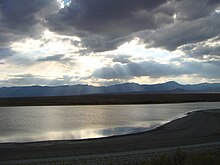
Mineralsbecome dissolved in the water as it moves through the undergroundrocks.This mineral content is measured astotal dissolved solids(TDS). This may give the water flavor and evencarbon dioxidebubbles, depending on the nature of thegeologythrough which it passes. This is why spring water is often bottled and sold asmineral water,although the term is often the subject ofdeceptiveadvertising.Mineral water contains no less than 250 parts per million (ppm) of tds. Springs that contain significant amounts of minerals are sometimes called 'mineral springs'. (Springs without such mineral content, meanwhile, are sometimes distinguished as 'sweet springs'.) Springs that contain large amounts of dissolvedsodiumsalts,mostlysodium carbonate,are called 'soda springs'. Many resorts have developed around mineral springs and are known asspa towns.Mineral springs are alleged to have healing properties. Soaking in them is said to result in the absorption of the minerals from the water. Some springs containarseniclevels that exceed the 10 ppbWorld Health Organization(WHO) standard fordrinking water.[16]Where such springs feed rivers they can also raise the arsenic levels in the rivers above WHO limits.[16]
Water from springs is usually clear. However, some springs may be colored by the minerals that are dissolved in the water. For instance, water heavy with iron ortanninswill have an orange color.[3]
In parts of the United States astreamcarrying the outflow of a spring to a nearby primary stream may be called aspring branch,spring creek,or run. Groundwater tends to maintain a relatively long-term average temperature of its aquifer; so flow from a spring may be cooler than other sources on a summer day, but remain unfrozen in the winter. The cool water of a spring and its branch may harbor species such as certaintroutthat are otherwise ill-suited to a warmer localclimate.
Types of mineral springs
[edit]
- Sulfur springs contain a high level of dissolvedsulfuror hydrogen sulfide in the water. Historically they have been used to alleviate the symptoms of arthritis and other inflammatory diseases.[17][18]
- Borax springs[19]
- Gypsum springs[5]
- Saline springs[20]
- Iron springs (chalybeate spring)[5]
- Radium springs (or radioactive springs) have a detectable level of radiation produced by the natural radioactive decay process[21][6]
Uses
[edit]
Springs have been used for a variety of human needs - including drinking water, domestic water supply, irrigation,mills,navigation, andelectricity generation.Modern uses include recreational activities such as fishing, swimming, and floating;therapy;water for livestock; fish hatcheries; and supply for bottledmineral wateror bottled spring water. Springs have taken on a kind of mythic quality in that some people falsely believe that springs are always healthy sources of drinking water. They may or may not be. One must take a comprehensive water quality test to know how to use a spring appropriately, whether for a mineral bath or drinking water. Springs that are managed as spas will already have such a test.
Drinking water
[edit]Springs are often used as sources for bottled water.[22]When purchasing bottled water labeled as spring water one can often find the water test for that spring on the website of the company selling it.
Irrigation
[edit]Springs have been used as sources of water for gravity-fed irrigation of crops.[23]Indigenous people of theAmerican Southwestbuilt spring-fedacequiasthat directed water to fields through canals. The Spanish missionaries later used this method.[24][25]
Sacred springs
[edit]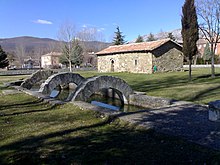
A sacred spring, or holy well, is a small body of water emerging from underground and revered in some religious context:Christianand/orpaganand/or other.[26][27]The lore and mythology ofancient Greecewas replete with sacred and storied springs—notably, theCorycian,PierianandCastaliansprings. In medieval Europe, pagan sacred sites frequently becameChristianizedas holy wells. The term "holy well" is commonly employed to refer to any water source of limited size (i.e., not a lake or river, but including pools and natural springs and seeps), which has some significance in localfolklore.This can take the form of a particular name, an associatedlegend,the attribution ofhealingqualities to the water through thenuminouspresence of its guardian spirit or of aChristian saint,or a ceremony orritualcentered on the well site.Christian legendsoften recount how the action of a saint caused a spring's water to flow - a familiar theme, especially in thehagiographyofCelticsaints.[citation needed]
Thermal springs
[edit]
The geothermally heated groundwater that flows from thermal springs is greater than human body temperature, usually in the range of 45–50 °C (113–122 °F), but they can be hotter.[6]Those springs with water cooler than body temperature but warmer than air temperature are sometimes referred to as warm springs.[28]
Bathing and balneotherapy
[edit]Hot springs or geothermal springs have been used forbalneotherapy,bathing, and relaxation for thousands of years. Because of the folklore surrounding hot springs and their claimed medical value, some have become tourist destinations and locations ofphysical rehabilitationcenters.[29][30]
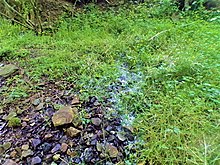
Geothermal energy
[edit]Hot springs have been used as a heat source for thousands of years. In the 20th century, they became a renewable resource of geothermal energy for heating homes and buildings.[29]The city ofBeppu, Japancontains 2,217 hot spring well heads that provide the city with hot water.[31]Hot springs have also been used as a source of sustainable energy for greenhouse cultivation and the growing of crops and flowers.[32]
Terminology
[edit]Cultural representations
[edit]Springs have been represented in culture through art, mythology, and folklore throughout history. TheFountain of Youthis a mythical spring which was said to restore youth to anyone who drank from it.[34]It has been claimed that the fountain is located inSt. Augustine, Florida,and was discovered byJuan Ponce de Leónin 1513. However, it has not demonstrated the power to restore youth, and most historians dispute the veracity of Ponce de León's discovery.[35][36]
Pythia, also known as theOracle at Delphiwas the high priestess of theTemple of Apollo.She delivered prophesies in a frenzied state of divine possession that were "induced by vapours rising from a chasm in the rock". It is believed that the vapors were emitted from the Kerna spring at Delphi.[37][38]
The Greek myth ofNarcissusdescribes a young man who fell in love with his reflection in the still pool of a spring. Narcissus gazed into "an unmuddied spring, silvery from its glittering waters, which neither shepherds nor she-goats grazing on the mountain nor any other cattle had touched, which neither bird nor beast nor branch fallen from a tree had disturbed." (Ovid)[39]
The early 20th century American photographer,James Reuel Smithcreated a comprehensive series of photographs documenting the historical springs of New York City before they were capped by the city after the advent of the municipal water system.[40]Smith later photographed springs in Europe leading to his book,Springs and Wells in Greek and Roman Literature, Their Legends and Locations(1922).[41]
The 19th century Japanese artistsUtagawa HiroshigeandUtagawa Toyokuni IIIcreated a series ofwood-block prints,Two Artists Tour the Seven Hot Springs (Sōhitsu shichitō meguri)in 1854.[42]
The Chinese cityJinanis known as "a City of Springs" (Chinese: Tuyền thành ), because of its 72 spring attractions and numerous micro spring holes spread over the city centre.[43][44]
-
John William Waterhouse Echo And Narcissus, 1903
-
Lucas Cranach,Der Jungbrunnen (Fountain of Youth),1546
-
Sokokura,from the seriesTwo Artists Tour the Seven Hot Springs (Sōhitsu shichitō meguri)byUtagawa Toyokuni IIIandUtagawa Hiroshige,1854
-
Oracle of Delphi, red-figure kylix, Kodros Painter, depicting Pythia with a cup presumably holding water from a spring, 440-430 BC
-
A Woman Drinks at the Carmen Spring, on West 175th Street and Amsterdam Avenue, New York City,by James Reuel Smith,c.1897–1902
-
Belqais Spring Garden,Charam, Iran,is aPersian gardenwhere all the water sources are springs located within it.

See also
[edit]- Fountain
- List of spa towns
- Petroleum seep
- Soakage
- Spring line settlement
- Spring supply
- Water cycle
- Well
References
[edit]- ^"Te Waikoropupū Springs".New Zealand Department of Conservation.Retrieved6 February2022.
- ^"Springs and the Water Cycle".usgs.gov.Retrieved14 November2021.
- ^ab"Springs - The Water Cycle, from USGS Water-Science School".ga.water.usgs.gov.Archived fromthe originalon 9 May 2009.
- ^abc"Well Design and Spring Development".National Engineering Handbook.January 2010.Archivedfrom the original on 21 October 2020.
- ^abcdBryan, Kirk (November 1919)."Classification of Springs".The Journal of Geology.27(7): 522–561.Bibcode:1919JG.....27..522B.doi:10.1086/622677.JSTOR30058415.S2CID129936821.Retrieved14 November2021.
- ^abcdPoehls, D.J.; Smith, Gregory J. (2011).Encyclopedic Dictionary of Hydrogeology.Elsevier Science.ISBN9780080925271.Retrieved15 November2021.
- ^Westbrook, Cherie J. (2017). "Heads Above Water: The Inside Story of the Edwards Aquifer Recovery Implementation Program by Robert L. Gulley".Great Plains Research.27(2): 143.doi:10.1353/gpr.2017.0022.ISSN2334-2463.S2CID133972692.
- ^Horstman, Mark (18 May 2006)."Wonky Holes".Catalyst transcript.Australian Broadcasting Corporation.Archivedfrom the original on 19 April 2019.Retrieved17 April2019.
- ^Whittow, John (1984).Dictionary of Physical Geography.London: Penguin. p. 291.ISBN0-14-051094-X.
- ^"Spring | water".Britannica.Archived fromthe originalon 25 July 2020.
- ^Cinta Pinzaru, Simona; Ardeleanu, Mircea; Brezestean, Ioana; Nekvapil, Fran; Venter, Monica M. (2019)."Biogeochemical specificity of adjacent natural carbonated spring waters from Swiss Alps promptly revealed by SERS and Raman technology".Analytical Methods; Royal Society of Chemistry.11(6).Retrieved15 November2021.
- ^abc"Springs of New Jersey"(PDF).
- ^ab"USGS Surface-Water Data for Missouri".waterdata.usgs.gov.Archivedfrom the original on 4 March 2018.Retrieved3 July2011.
- ^Vineyard and Fender, 1982. p. 12
- ^"Thousand Springs Research Project".9 May 2006. Archived fromthe originalon 12 December 2012 – via University of Idaho.
- ^abLi, Chaoliu; Kang, Shichang; Chen, Pengfei; Zhang, Qianggong; Mi, Jue; Gao, Shaopeng; Sillanpää, Mika (2014). "Geothermal spring causes arsenic contamination in river waters of the southern Tibetan Plateau, China".Environmental Earth Sciences.71(9): 4143–4148.Bibcode:2014EES....71.4143L.doi:10.1007/s12665-013-2804-2.S2CID128479153.
- ^Pearl, Richard Howard; Ringrose, Charles D.; Zacharakis, Ted G. (1982)."Geothermal Resource Assessment of Hot Sulphur Springs, Colorado".Colorado Geological Survey.Retrieved14 November2021.
- ^Gemici, Burcu; Wallace, John L."Encyclopedia of Inland Waters".Retrieved15 November2021.
- ^Zakrajsek, John R. (2006).Identifying Systematic Behaviors in Borax Lake Geothermal Springs, Southeast Oregon.University of Idaho.Retrieved14 November2021.
- ^Bischoff, Matt C. (2018).Touring California and Nevada hot springs.Guilford, Connecticut: Falcon Guides.ISBN9781493029112.Retrieved14 November2021.
- ^Leonard, Robert B.; Janzer, Victor J. (July–August 1978)."Natural radioactivity in geothermal waters, Alhambra Hot Springs and nearby areas, Jefferson County, Montana"(PDF).Journal of Research of the U.S. Geological Survey.6(4).Retrieved14 November2021.
- ^Royte, Elizabeth (2011).Bottlemania: Big Business, Local Springs, and the Battle Over America's Drinking Water.Bloomsbury Publishing.ISBN978-1596913721.Retrieved14 November2021.
- ^Clement, Christopher Ohm; Moseley, Michael E. (1991). "The Spring-Fed Irrigation System of Carrizal, Peru: A Case Study of the Hypothesis of Agrarian Collapse".Journal of Field Archaeology.18(4): 425–443.doi:10.1179/009346991791549059.
- ^"Acequias and River Systems".Retrieved15 November2021.
- ^Romero, Simon (13 July 2021)."Drought Hits the Southwest, and New Mexico's Canals Run Dry".The New York Times.Retrieved15 November2021.
- ^Ray, Celeste (2011). "The Sacred and the Body Politic at Ireland's Holy Wells".International Social Science Journal.62(205/206): 271–85.doi:10.1111/issj.12000.
- ^Byrne, Garreth (2002). "Holy Wells in Britain and Ireland".Contemporary Review.280(1636): 295 – viaEBSCOhost.
- ^Pentecost, Allan; Jones, B.; Renault, R.W. (2003)."What is a hot spring?".Canadian Journal of Earth Sciences.40(11): 1443–1446.Bibcode:2003CaJES..40.1443P.doi:10.1139/e03-083.Retrieved15 November2021.
- ^abvan Tubergen, A (1 March 2002)."A brief history of spa therapy".Annals of the Rheumatic Diseases.61(3): 273–275.doi:10.1136/ard.61.3.273.PMC1754027.PMID11830439.
- ^"A History of Geothermal Energy in America".U.S. Department of Energy Efficiency and Renewable Energy.Retrieved30 October2020.
- ^Holtz, Michael (9 March 2018)."Japan builds a head of steam for an alternative to nuclear".Christian Science Monitor.Retrieved17 November2021.
- ^"Case Studies in Hot Spring Use for Sustainable Energy"(PDF).Oita Prefectural Government.Retrieved17 November2021.
- ^abcd"Springs characteristics".
- ^Sowers, Lloyd (25 October 2021)."Water from St. Pete's famed Fountain of Youth contained high levels of lithium".FOX 13 News.Retrieved11 November2021.
- ^Connolly, Patrick (5 November 2020)."St. Augustine Fountain of Youth may be Florida's oldest attraction".orlandosentinel.Retrieved11 November2021.
- ^Shaer, Matthew (June 2013)."Ponce De Leon Never Searched for the Fountain of Youth".Smithsonian Magazine.Retrieved11 November2021.
- ^Broad, William J. (19 March 2002)."For Delphic Oracle, Fumes and Visions".The New York Times.Retrieved13 November2021.
- ^Hale, John R.; de Boer, Jelle Zeilinga; Chanton, Jeffrey P.; Spiller, Henry A. (August 2003)."Questioning the Delphic Oracle".Scientific American.289(2): 66–73.Bibcode:2003SciAm.289b..66H.doi:10.1038/scientificamerican0803-66.JSTOR26060404.PMID12884540.Retrieved13 November2021.
- ^Nelson, Max (April–May 2000)."Narcissus: Myth and Magic".The Classical Journal.95(4): 363–389.JSTOR3298150.Retrieved13 November2021.
- ^"James Reuel Smith springs and wells photograph collection 1893–1902 – Brooklyn collection".New York Historical Society digital collection.Retrieved13 November2021.
- ^Smith, James Reuel (1922).Springs and Wells in Greek and Roman Literature.New York and London: G.P. Putnam's Sons.Retrieved13 November2021.
- ^"Sokokura, from the series Two Artists Tour the Seven Hot Springs (Sōhitsu shichitō meguri)".Fine Arts Museum of San Francisco.Retrieved13 November2021.
- ^"Overview - Jinan, a City of Springs".english.jinan.gov.cn.Retrieved20 July2022.
- ^"Jinan: a City of Springs".The World of Chinese.Retrieved20 July2022.
Further reading
[edit]- LaMoreaux, Philip E.; Tanner, Judy T, eds. (2001),Springs and bottled water of the world: Ancient history, source, occurrence, quality and use,Berlin, Heidelberg, New York: Springer-Verlag,ISBN3-540-61841-4
- Springs of Missouri,Vineyard and Feder,Missouri Department of Natural Resources,Division of Geology and Land Survey in cooperation withU.S. Geological Surveyand Missouri Department of Conservation, 1982
- Cohen, Stan (Revised 1981 edition),Springs of the Virginias: A Pictorial History,Charleston, West Virginia:Quarrier Press.

